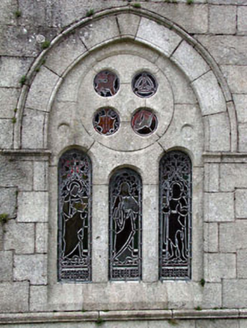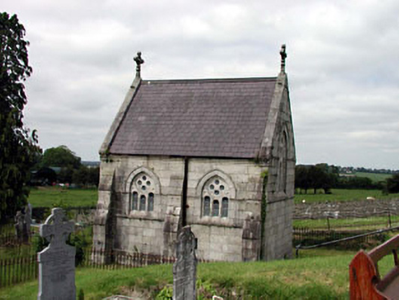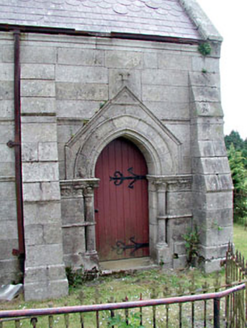Survey Data
Reg No
11903607
Rating
Regional
Categories of Special Interest
Architectural, Artistic, Historical, Social
Previous Name
Trinity Catholic Church
Original Use
Church/chapel
In Use As
Church/chapel
Date
1860 - 1880
Coordinates
279724, 192049
Date Recorded
24/10/2002
Date Updated
--/--/--
Description
Detached two-bay single-storey over-basement granite ashlar Romanesque-style mortuary chapel, c.1870. Gable-ended roof with slate (scalloped fish-scale to courses). Clay ridge tiles. Cut-stone coping to gables with cross finials. Cast-iron rainwater goods on moulded eaves band. Granite ashlar walls. Stepped buttresses. Moulded stringcourses. Cut-stone plaque to gable to west with hood moulding over. Cut-limestone plaque to west. Pointed-arch window openings. Chamfered sills. Moulded archivolts. Round-headed windows with fixed-pane diamond-leaded stained glass windows having oculus openings over in disc surround. Rose window to gable to west in round-headed recessed surround having colonettes. Oculus openings in disc surround. Pointed-arch door opening. Cut-granite doorcase including colonettes with foliate capitals having shallow gable over. Tongue-and-groove timber panelled door with decorative iron hinges. Square-headed door opening to basement (crypt) to east approached by flight of steps. Now blocked-up (red brick). Sited in graveyard. Cast-iron railings to boundary with fleur-de-lis finials.
Appraisal
This mortuary chapel is a fine and highly ornate Victorian piece of considerable architectural heritage merit. Built for the internment of Robert Archibald of Davidstown - a patron of considerable wealth - no expense was apparently spared in its design and construction. A good example of the Romanesque style, each elevation is highly decorated through the use of cut-granite and delicate fenestration. The construction in, and delicate carving of, the locally-sourced granite is of great merit and testifies to the high quality of stone masonry practised in the locality - the carving, in particular, has retained a crisp intricacy. The chapel is attractively set in a prominent position on a hill-top in the graveyard of the Catholic Church of the Blessed Trinity (11903606/KD-36-06), acting as a decorative foil to the austere quality of that church, and is surrounded by fine sections of ornate cast-iron railings.





